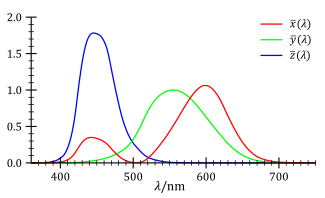CIE XYZ color space
- Main article: CIE 1931 color space

CIE 1931 Standard Colorimetric Observer functions between 380 nm and 780 nm (at 5 nm intervals).
Note that the tabulated sensitivity curves have a certain amount of arbitrariness in them. The shapes of the individual X, Y and Z sensitivity curves can be measured with a reasonable accuracy. However, the overall luminosity function (which in fact is a weighted sum of these three curves) is subjective, since it involves asking a test person whether two light sources have the same brightness, even if they are in completely different colors. Along the same lines, the relative magnitudes of the X, Y, and Z curves are arbitrary. One could as well define a valid color space with an X sensitivity curve that has twice the amplitude. This new color space would have a different shape. The sensitivity curves in the CIE 1931 and 1964 xyz color space are scaled to have equal areas under the curves.
Sometimes XYZ colors are represented by the luminance, Y, and chromaticity coordinates x and y, defined by:
The values for X, Y, and Z are obtained by integrating the product of the spectrum of a light beam and the published color-matching functions.


No comments:
Post a Comment